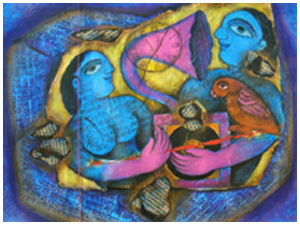He paints for deriving aesthetic pleasure.
His work is neither a statement on anything nor it means
to fight any notions or traditions. There are bodies
halved into the shapes of human and animal. Strange
objects fly around. An antique Roman clock invariably
features somewhere. Everything seems like having been
caught in a time warp. A true communication or communion
is on between one colour and another, between object
and subject and things and thoughts.
Critic Umesh Verma has written, "Singh is a virile
painter from Rajasthan. Calligraphic textures and through
inner alchemic processing he creates highly decorative
folkishly sweet objects and paintings. His process is
more or less scientific and has obvious overtones of
Rajasthan. Sweetness and mirage are the reason for the
essence of his visuals. He invokes poetic-Lingo."
His canvasses are textured and layered over and over.
Perhaps he hates leaving any empty space on canvass
and embellishes and decorates every object. He profusely
uses different scriptures like Arabic, Persian, Urdu
and even English. The couplets used don't make any statement.
They on their own don't represent anything, but he does
not use the symbols for the heck of it. To decipher
them, they need to be viewed in totality, keeping in
mind the objects painted. Otherwise, they are there
for purely decorative purpose. A line with a shadow,
cutting across the canvass, gives a sense of perspective
to the painting. The concept is similar to one employed
in old scrolled miniatures. Lines make a viewer stop
and ponder; line-break the monotony and depth. Medium
is not a barrier to him.
In the paintings with a mythological theme, he depicts
different forms of Lord Ganesha, Lord Krishna, Goddess
Durga and the Sun God. Art critic Keshav Malik, who
has reviewed his work from early days, writes, "Singh's
apparitions from the cultural past cause nostalgia in
viewers. This same dreamscape brims with the personae
of charming figments, of birds, fish, beast and humans,
of objects from both past and present. Here there are
motifs from the foregoing Rajasthani painting as well
as images of mundane objects of the day. All these have
blended thoroughly." Malik adds, "No feel
of over-crowding or of congestion. The ecology of his
compositions, in other words, is just right; it suggests
the interdependence of each on all, and of live and
let live. This at least was the earlier Indian cultural
methodology."
In an interview, he told that he does not always go
by set patterns. Some of his paintings extend to or
beyond the frame. He started with abstract before slowly
switching to figurative. May be, he has now come a full
circle as he again feels like doing abstract. While
concerning about declining art traditions, he feels
that puppetry, folk dances, scroll painting, tattoo,
etc belong to the rich art tradition. If no attention
is provided to their revival, these will simply vanish.
One Man Shows
- AIFACS, New Delhi, 1982
- Information Centre, Udaipur, 1983
- Contemporary Art Gallery, Ahmedabad, 1983
- Art Gallery, School of Arts, Jaipur, 1984
- Art Gallery, Faculty and Fine Art, Baroda, 1984
- Shridharani Art Gallery, New Delhi 1984, 1991, 2000,2003,
2005
- Jehangir Art Gallery, Mumbai,1985,1994, 1998, 2000,
2006
- Dhoomimal Art Centre, New Delhi 1986
- Chitrakoot Art Gallery, Calcutta, 1987, 1989, 1994,
2003
- Bajaj Art Gallery, Mumbai, 1986, 1990
- Chetana Art Gallery, Mumbai, 1987
- Taj Art Gallery, Mumbai, 1987, 1991, 1994, 2002
- Gallery Aurobido, New Delhi 1989, 1991, 1994
- Jawahar Kala Kendra, Jaipur 1993, 1998, 2001, 2006
- Welcome Gallery, Rajputana Palace Sheraton, Jaipur
1995, 2002, 2004
- Dhoomimal Gallery, New Delhi 1995, 1998, 2002, 2004
- Srishti Art Gallery, Lucknow, 1996
- Ravi Shankar Raval Bhawan, Ahmedabad ,1996
- Durga`s Art Gallery, Mumbai,1996
- Nehru Centre, Mumbai, 1997
- Son-et-Lumiere, Mumbai, 1999, 2003
- Westminster Art Gallery, Bangalore, 1999
- Jamaat, Mumbai, 2000
- ABC Gallery, Varanasi, 2001
- Gallery Jan Steen, Amsterdam, Holland, 2001
- Department of Fine Arts, Chandigarh ,2002
- Daffodils Art Gallery, The Grand Hyatt, New Delhi
,2003
- Ta BLU Café Gallery Bar, Clarks Amer, Jaipur,
2004
- Crimson-the art resources, Bangalore, 2005
Awards and Honours
- National Award, Lalit Kala Akademy, New Delhi, 1984
- Rajasthan Lalit Kala Akademy, Jaipur 1995
- Bombay Art Society 1985, 1987
- U.P. State Lalit Kala Akademy Lucknow, 1984
- The Indian Akademy of Fine Art, Amritsar, 1983,
1987, 1990
- Hyderabad Art Society, Hyderabad, 1984
- Ankan kala parishad,Bhilwara,2004
- Tulika Kalakar Parishad, Udaipur, 1977, 1980
- A.P. Council of Artists, Hyderabad, 1984
- Mahakaushal Kala Parishad, Raipur, 1984, 1990
- Oriental Art Society, Calcutta, 1985
- Karnataka Chitrakala Parishad, Bangalore, 1985
- Creators, Ambala Cantt., 1985, 1990
- Bharatha Kala Parishad, Hyderabad, 1988
- South Central Zone Culture Centre, Nagpur, 1990
- Banaras Artists Association, Banaras, 1992
- 1st Indian Drawing Biennial, The Solids Chandigarh,
1992
- Research Scholarship, National Lalit Kala Akademy,
New Delhi, 1986
- All India Art Biennial of Rajasthan, Jaipur, 1997
- All Indian Art Biennial of Rajasthan, Jaipur 2000
- Nagridas kala sansthan, Kishangarh, Ajmer,2000
- Honour by His Excellency The Governor of Tamil Nadu,
2006

back |



